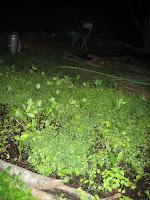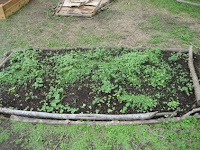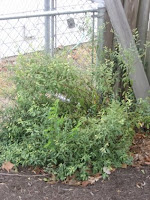I've done some research on a few of the things I've planted to discover the commonalities in those that died or are wilty versus those that are neutral or doing well.
The 'will fleming' yaupon holly does not like chalky soils and also required more water than other plants I bought. It was also a cultivar rather than a hardy native. It died.
The inland sea oats is not so happy. It apparently does not like chalk and likes slightly acidic soil. Similar to the American Beautyberry.
It turns out that desert willow has a medium tolerance for calcium carbonate (chalky stuff), so I will be keeping an eye on it but it does like alkaline soil. So far, it is not exactly happy or sad, but pretty neutral.
The gulf muhly is doing well even though it has similar requirements to the inland sea oats in many ways except that it likes alkaline soil. I take this to mean that I should really stay away from plants that prefer any kind of acid soil.
Bamboo muhly also pretty happy likes mildly alkaline soil and though it likes regular water, doesn't like to be overwatered.
The Hacienda Vine has managed to live though I have not watered it nearly enough for a vine. It like alkaline soil.
The hops bush has managed to survive even though I didn't water it enough and planted it in the heat of the summer. It has a wider ph happiness.
Maiden Grass 'Gold Bar' also has a wider ph happiness and seems to be doing fine. I didn't know they grew as big as the website is saying. 5 feet after 8 years. A slow growth, but still pretty big.
Mexican feathergrass yet another wider ph plant, also seems to be pretty happy. It also doesn't need much water. On the other hand it seems to be dangerous to dogs, or at least that seems to be a major complaint.
The indian grass seems to be okay even though it was root bound. It has a high tolerance for calcium carbonate and seems to flourish in a wide variety of locations. It seems to have a wider ph tolerance, but more in the acid direction to just mildly alkaline.
Primrose Jasmine has a wide ph happiness, but needs water. It is wilty a little probably because I haven't managed to water it enough. Ah well.
Coral honeysuckle is similar in to the desert willow in that it is okay with a medium amount of calcium carbonate. I planted to tiny ones. One is doing really well and one is not so great. They are planted only two feet away from each other. Not sure what the deal is, maybe I pounded down the soil a little too much around the unhappy one or the other one is sucking up all the available water.
I'm thinking that the mountain laurel didn't like the front yard more because it gets more water since it is at the bottom of the slope our house is located on. I'm also thinking I better test the soil ph in front since it has more grass, shade, and trees.
Sadly, what would by most people be considered weeds in my yard that I like don't really seem to have available ph information or soil preferences per say. I know in some of the books I read that certain weeds are good indicators of the type of soil one has. My weeds are pretty and likeable, but fairly soil mysterious.
Things I need to keep in mind as I choose plants: Calcium Carbonate tolerance, Alkalinity, Watering needs. It seems that chalk and ph make the most difference in survival rather than watering. I'm not sure what to think about cultivars, I suspect in some cases they are a bit more difficult than native varieties and in others they were developed to be really hardy.
Lots of plants on my list to check out...
 I've added pine straw around the plants to discourage weeds. I've also put in another purple scullcap (I think it is call heartleaf skullcap). All the green around the beds is horseherb, some stray grass (not st.augustine, I don't think), and a weed here and there (wood-sorrel and icky bent-leaf spurge which secretly I think is pretty though I have been pulling it up where I find).
I've added pine straw around the plants to discourage weeds. I've also put in another purple scullcap (I think it is call heartleaf skullcap). All the green around the beds is horseherb, some stray grass (not st.augustine, I don't think), and a weed here and there (wood-sorrel and icky bent-leaf spurge which secretly I think is pretty though I have been pulling it up where I find).


 After 15 minutes and the rain stopping, there is barely any water left.
After 15 minutes and the rain stopping, there is barely any water left.




 manperson. He has in last week: halfway removed two crepe myrtle stumps that are in the way of our drainage project, he organized the garage so that I could get to the gardening tools easier, and most impressive of all mowed the lawn today just like he said he was going to. I'm not sure how I feel about the lawn being mowed. On one hand it both looks nicer and less nice. I was kind of enjoying the renegade grass stalks.
manperson. He has in last week: halfway removed two crepe myrtle stumps that are in the way of our drainage project, he organized the garage so that I could get to the gardening tools easier, and most impressive of all mowed the lawn today just like he said he was going to. I'm not sure how I feel about the lawn being mowed. On one hand it both looks nicer and less nice. I was kind of enjoying the renegade grass stalks.









 w friends, the rain, or the bevy of new beneficial insects these new flowering perennials attract. I'm seeing bees everyday and am now actually finding earthworms in the soil. I am also seeing new birds not just the nasty grackles.
w friends, the rain, or the bevy of new beneficial insects these new flowering perennials attract. I'm seeing bees everyday and am now actually finding earthworms in the soil. I am also seeing new birds not just the nasty grackles.


























